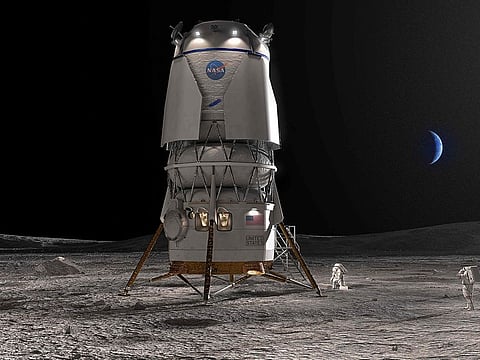UAE ignites Artemis gateway with Airlock breakthrough
Collaboration between Nasa and UAE to provide humanity’s first space station to orbit Moon

In a groundbreaking announcement on Sunday, Nasa and the Mohammed bin Rashid Space Centre (MBRSC) unveiled a collaborative effort to integrate an airlock into Gateway, humanity’s inaugural space station positioned in lunar orbit.
This move signals a significant stride in advancing space exploration and fostering global partnerships for the benefit of all.
President His Highness Sheikh Mohamed bin Zayed Al Nahyan expressed his pleasure, stating on X (formerly Twitter): “I was pleased to attend with my brother Mohammed bin Rashid the launch of the UAE’s contributions to the historic Lunar Gateway, which will serve as humanity’s first space station around the Moon. Through our long-term investment in space exploration and scientific innovation, the UAE is determined to work alongside its international partners to enable collective progress for all.”
A historic milestone
The lunar space station, a cornerstone of NASA’s extended lunar exploration missions under the Artemis program, promises far-reaching benefits for humanity.
US Vice President Kamala Harris, also chair of the National Space Council, underscored the importance of international collaboration in space, applauding the synergy between the United States and the UAE. She envisioned a harmonious blend of resources, scientific capabilities, and technical expertise, ensuring unparalleled opportunities for Earth’s inhabitants.
As part of an expanded collaboration with Nasa, MBRSC will contribute the Crew and Science Airlock module to Gateway, accompanied by an Emirati astronaut slated for a future Artemis mission to the lunar space station.
Nasa Administrator Bill Nelson hailed this collaboration as a historic milestone, emphasising that the UAE’s provision of the airlock would enable groundbreaking scientific endeavours in deep space, laying the groundwork for eventual human missions to Mars.
MBRSC’s role
MBRSC’s role goes beyond airlock operation, extending to engineering support throughout the lunar space station’s lifespan.
The airlock will facilitate seamless transfers of crew and scientific research between Gateway’s pressurised crew modules and the vacuum of space, enabling extensive scientific exploration and maintenance activities in the deep space environment.
Gateway, designed for sustained exploration and research in deep space, serves as a habitat for astronauts, a staging point for lunar surface missions, and an opportunity for spacewalks while orbiting the Moon.
This collaborative effort builds upon NASA’s existing partnerships with the Canadian Space Agency (CSA), European Space Agency (ESA), and Japan Aerospace Exploration Agency (JAXA), with MBRSC joining the coalition to contribute to human space exploration.
New frontier of human exploration
The collaboration between Nasa and the UAE, particularly with MBRSC, follows previous joint endeavours, including the 2019 mission where Hazzaa Al Mansoori became the first Emirati in space.
Sultan Al Neyadi’s participation in NASA’s SpaceX Crew-6 mission in 2023 and ongoing astronaut training for two additional Emirati candidates underscore the UAE’s steadfast commitment to space exploration.
The agreement solidifies the UAE’s dedication to the Artemis Accords, guiding international cooperation in NASA’s lunar exploration program. This collaboration marks a crucial step in advancing the Artemis mission, aiming to land the first woman and the first person of colour on the lunar surface, setting the stage for future human missions to Mars.
The UAE’s dedication to space exploration and scientific innovation positions the nation as a proactive international partner contributing to collective progress in the realm of space exploration, further cementing its role as a pioneer in the new frontier of human exploration beyond Earth.
What is the Lunar Gateway?
Nasa is constructing this vital station on Earth before initiating assembly in the Moon's orbit within this decade. Integral to the US space agency's Artemis programme, the Lunar Gateway is designed to establish a lasting human presence on the Moon. Astronauts will utilise the Lunar Gateway for Artemis missions, descending to the Moon's surface via landing modules developed by SpaceX and Blue Origin. The current UAE-US agreement exclusively secures access to the station.
Sign up for the Daily Briefing
Get the latest news and updates straight to your inbox



